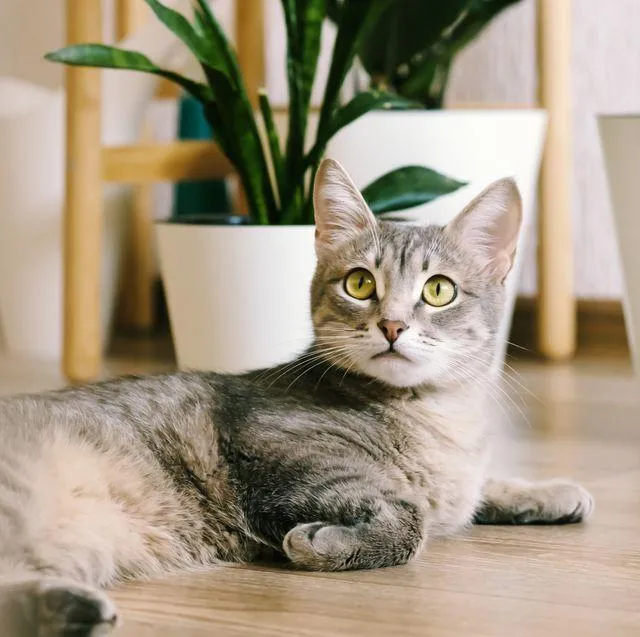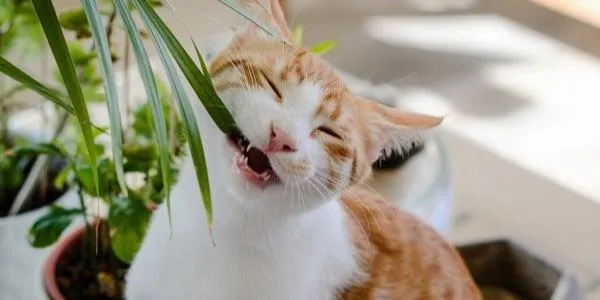Are Houseplants Safe for Cats?
If you have both houseplants and cats, you may be wondering about any potential dangers. From my experience as a vet tech, houseplants can definitely pose some risks to cats that owners need to be aware of. In this article, I’ll explore the main concerns with various common houseplants and provide tips to keep your furry friends safe.
Toxic Houseplants
- Lilies: All types of lilies, like Easter lilies and tiger lilies, are extremely toxic to cats and can cause kidney failure. Even small amounts of pollen, leaves, or petals ingested are dangerous.
- Dieffenbachia (dumb cane): All parts of these plants contain calcium oxalate crystals that can cause severe mouth and digestive irritation if eaten.
- Sago palm: The seeds and leaves of sago palms contain cycads, which are poisonous and may be lethal if consumed by cats.
- Philodendron: While philodendron toxicity varies by species, many contain calcium oxalate crystals and oxalic acid, which may cause drooling, vomiting, and mouth irritation.
- Aloe vera: Despite its medicinal uses for humans, aloe vera sap can cause digestive upset if ingested by cats.
I’ve unfortunately seen cats get very ill from ingesting toxic plants like Easter lilies. The symptoms range from drooling and vomiting to more severe issues like kidney damage. It’s always better to be safe than sorry when it comes to our furry friends’ health.
Non-Toxic Plants, But Still a Risk
Even houseplants that are considered non-toxic can still pose ingestion risks if cats chew on or swallow leaves, flowers, or dirt. Some of these include:
- Peace lilies: While the plant itself is generally non-toxic, peace lilies can irritate a cat’s mouth due to naturally occurring calcium oxalate crystals.
- Pothos: Also known as devil’s ivy, pothos is mildly toxic and can cause digestive upset.
- Spider plants: Not toxic but fibers on leaves can cause choking or blockages if ingested.
- Ferns: Most varieties aren’t toxic, but large fronds present a chewing or swallowing hazard.
Basically, any houseplant carries some risk level that varies cat to cat. It’s kind of like how some people can handle spicier foods than others. You never know how your individual cat will react until it’s too late.
Tips for Plant Safety
To keep houseplants and kitties living in harmony, here are some suggestions gleaned from my years of experience:

- Place toxic and appealing plants up high, preferably out of paw and jump reach.
- Cover soil surfaces of all plants with gravel to discourage chewing and ingestion of dirt.
- Pot plants in containers with no drainage holes to prevent knocked-over pots from spilling soil.
- Provide your cats with other appealing living toys, like catnip or interactive wand toys as alternatives.
- Monitor plants for signs of chewing and promptly remove affected areas.
- Keep an eye on cats near plants and deter undesirable behavior with spray bottles, if needed.
- Have poison control numbers handy just in case, and contact a vet right away if a cat ingests part of a plant.
By taking some basic precautions, you can enjoy houseplants without the worry. Keep kitties occupied and stimulated in other ways besides plants. With a little care and supervision, most cats and houseplants can coexist in harmony.
Dealing with an Ingestion Incident
Despite all precautions, plant ingestions still sometimes happen. I’ve seen a few cases over the years that basically teach you can’t always watch them every second. Here’s what to do if Fifi eats a leaf:
- Remain calm – stress will only make the situation worse.
- Contact your vet ASAP – do not induce vomiting without guidance.
- Gather a sample of the ingested plant for identification if possible.
- Monitor the cat closely for any signs of distress like vomiting, diarrhea, lethargy.
- Seek immediate emergency care for large ingestions or concerning symptoms.
Acting quickly upon plant ingestion greatly improves outcomes. Honestly, it’s awesome the lengths vets will go to save an animal – one clinic literally had an herbal database! While it’s scary in the moment, staying collected helps your fur baby the most.
Making Accommodations
If preventing access simply isn’t possible given your cat’s personality or home layout, here are some alternatives worth considering to still enjoy greenery:
- Invest in artificial plants like silk or plastic – cats can’t distinguish the difference!
- Install high shelving, hanging planters or tall plant stands out of reach.
- Replace houseplants with safe outdoor container gardening on patios instead.
- Board toxic plants in another unoccupied room when unattended.
- Grow edible produce like wheatgrass that’s beneficial if nibbled in moderation.
- Consult an expert indoor plant designer for creative barrier solutions.
With imagination, almost any home situation can achieve harmony between houseplants and pets. It just takes getting kinda creative – which is part of the fun! You and kitty will both be happier in the end.

Beware Other Hazards
Beyond just plants themselves, a few other common home décor pieces warrant mention as potential dangers:
- Fresh flowers like lilies, tulips and roses may contain toxic pollen or substances.
- Potting soil, compost and fertilizers can pose risks if ingested in large amounts.
- Decorative rocks, pebbles or stones run risks of blockage if swallowed.
- Plant pots, terra cotta or plastic, pose ingestion/choking risks if chewed or broken.
- Strings, wires, or holiday tinsel strung on plants may prove entangling or nasty if swallowed.
Basically, anything near or associated with plants deserves scrutiny from a safety standpoint. Be alert to anything that seems out of place if you notice odd symptoms. Prevention’s ideal, but vigilance in general helps, too.
In conclusion, while you can absolutely have houseplants and cats coexisting safely, some research, precautions and adaptations may be necessary depending on individual situations. With awareness of toxins, risks and cat-proofing strategies, the reward of indoor greenery can be enjoyed without worries. Just use common sense and trust your instincts – it usually sorts itself out!
Houseplants That Are Safe for Cats
| Plant | Safety Level | Notes |
|---|---|---|
| Peace Lily | Cat-Safe | Toxic if ingested but not appealing to cats. Non-toxic if leaves are just brushed against. |
| English Ivy | Low Toxicity | May cause mild digestive upset if ingested. Best to keep out of reach. |
| Spider Plant | Cat-Safe | Non-toxic and great for indoor air purification. Popular choice! |
| Pothos | Low Toxicity | Potentially irritating if eaten. Keep leaves out of reach to be safe. |
| Snake Plant | Cat-Safe | Very pet-friendly and tough. Adds greenery with little care needed. |
FAQ
-
Are there any flowering houseplants that are safe for cats?
Yes, there are some flowering plants that usually aren’t poisonous to cats. Peace lilies and some orchids like phalaenopsis are commonly said to be basically okay for cats. At the same time, every animal is different – your cat may possibly chew on or try to eat the plant parts. So it’s good to still be careful with any houseplant.
-
What about non-flowering houseplants – are any of those safe?
Most popular non-flowering houseplants seem to be alright for cats. Snake plants and pothos are often said to have basically no toxins. Chinese evergreens and lucky bamboo also appear to be pretty safe. Nevertheless, it’s still best not to leave your cat alone for long with any houseplants, just in case.

-
Should I be worried about poisonous pollen or sap from houseplants?
While the pollen and sap from most houseplants is nothing for humans to worry about, it could be an issue for cats. Their tiny bodies process things differently than ours. So when in doubt, it’s better to just go with non-flowering, low-maintenance kinds of houseplants if you’ve got a curious kitty around. Better safe than sorry!
-
What about the soil – can houseplant soil poison a cat?
Cat owners do need to watch out for houseplant soil. Some common potting soils contain fertilizers or other additives that could make a cat sick if eaten. It’s always a good idea to use fertilizer sparingly, if at all, and keep the soil in the pot where it belongs! Cats may dig in plants now and then to “bury” their business, so be sure to sweep up any spilled soil right away.
-
Are there any houseplants that are definitely unsafe for cats?
There are a few popular houseplants you’ll want to watch out for if you’ve got cats. English ivy, philodendron, and peace lilies can be toxic. Poinsettias are also well known as not safe at any time of year. And of course lilies – all kinds of lilies are very dangerous for cats no matter the variety. It’s probably best to avoid bringing these into a home with curious kitties!
In summary, many common “safe” houseplants could still pose some risk depending on an individual cat’s behavior. It’s always a good idea to do your own research if you notice your cat showing interest in plants. You may want to contact an animal poison control hotline or your vet if you feel unsure about anything. Ultimately, prevention is key – try to keep plants, soils, and other supplies well out of your cat’s reach whenever possible!
Do you have any other questions about houseplants and cats? I’d be happy to help if I can. But I’m no expert – perhaps check with an experienced vet as well. Safety should be the top priority when pet-proofing your home. I hope this FAQ helped provide a starting point for plant lovers with furry friends!

